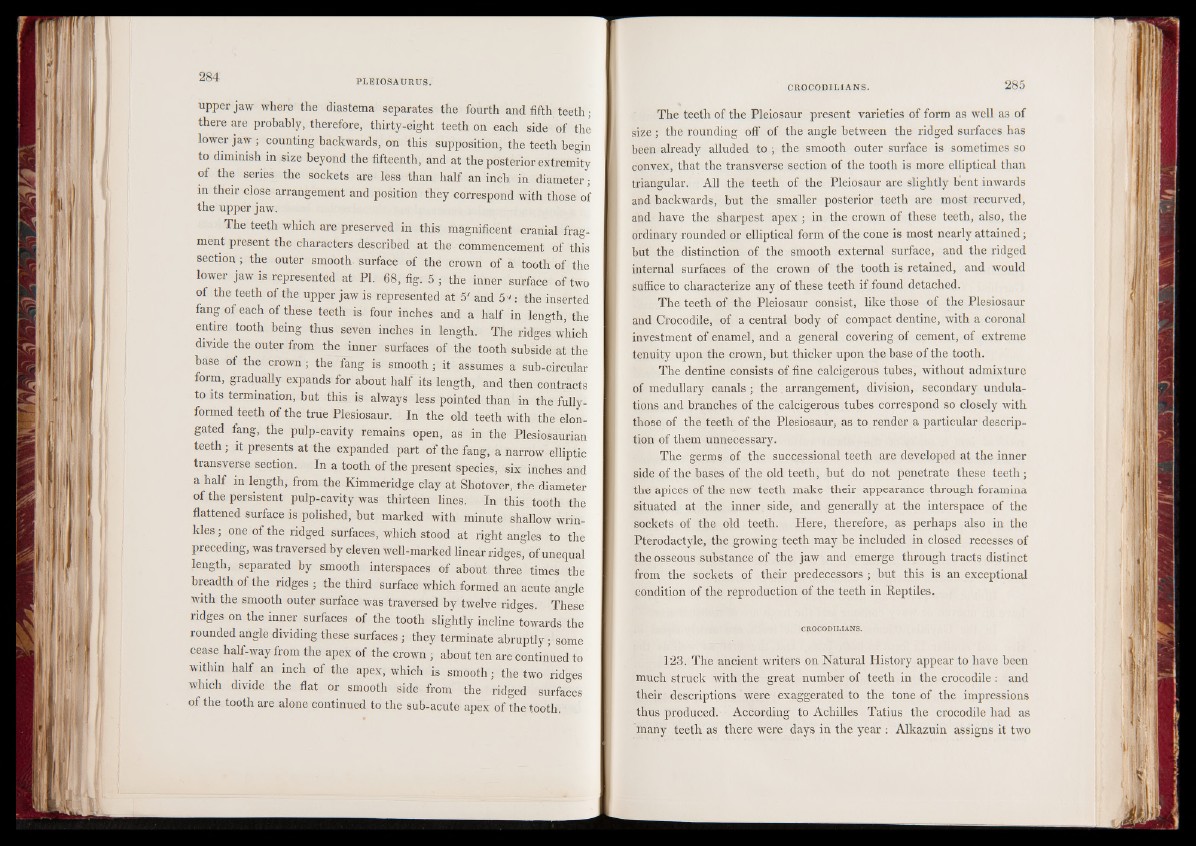
upper jaw where the diastema separates the fourth and fifth teeth;
there are probably, therefore, thirty-eight teeth on each side of thé
lower jaw ; counting backwards, on this supposition, the teeth begin
to diminish in size beyond the fifteenth, and at the posterior extremity
of the series the sockets are less than half an inch in diameter;
in their close arrangement and position they correspond with those of
the upper jaw.
The teeth which are preserved in this magnificent cranial fragment
present the characters described at the commencement of this
section ; the outer smooth surface of the crown of a tooth of the
lower jaw is represented at PI. 68, fig. 5 ; the inner surface of two
of the teeth of the upper jaw is represented at 5' and 5 ": the inserted
fang of each of these teeth is four inches and a half in length, the
entire tooth being thus seven inches in length. The ridges which
divide the outer from the inner surfaces of the tooth subside at the
base of the crown ; the fang is smooth; it assumes a sub-circular
form, gradually expands for about half its length, and then contracts
to its termination, but this is always less pointed than in the fully-
formed teeth of the true Plesiosaur. In the old teeth with the elongated
fang, the pulp-cavity remains open, as in the Plesiosaurian
teeth; it presents at the expanded part of the fang, a narrow elliptic
transverse section. In a tooth of the present species, six inches and
a half in length, from the Kimmeridge clay at Shotover, the diameter
of the persistent pulp-cavity was thirteen lines. In this tooth the
flattened surface is polished, but marked with minute shallow wrinkles
; one of the ridged surfaces, which stood at right angles to the
preceding, was traversed by eleven well-marked linear ridges, of unequal
length, separated by smooth interspaces of about three times the
breadth of the ridges ; the third surface which formed an acute angle
with the smooth outer surface was traversed by twelve ridges. These
ridges on the inner surfaces of the tooth slightly incline towards the
rounded angle dividing these surfaces ; they terminate abruptly; some
cease half-way from the apex of the crown g about ten are continued to
within half an inch of the apex, which is smooth; the two ridges
which divide the flat or smooth side from the ridged surfaces
of the tooth are alone continued to the sub-acute apex of the tooth.
The teeth of the Pleiosaur present varieties of form as well a3 of
size ; the rounding off of the angle between the ridged surfaces has
been already alluded to ; the smooth outer surface is sometimes so
convex, that the transverse section of the tooth is more elliptical than
triangular. All the teeth of the Pleiosaur are slightly bent inwards
and backwards, but the smaller posterior teeth are most recurved,
and have the sharpest apex ; in the crown of these teeth, also, the
ordinary rounded or elliptical form of the cone is most nearly attained ;
but the distinction of the smooth external surface, and the ridged
internal surfaces of the crown of the tooth is retained, and would
suffice to characterize any of these teeth if found detached.
The teeth of the Pleiosaur consist, like those of the Plesiosaur
and Crocodile, of a central body of compact dentine, with a coronal
investment of enamel, and a general covering of cement, of extreme
tenuity upon the crown, but thicker upon the base of the tooth.
The dentine consists of fine calcigerous tubes, without admixture
of medullary canals ; the , arrangement, division, secondary undulations
and branches of the calcigerous tubes correspond so closely with
those of the teeth of the Plesiosaur, as to render a particular description
of them unnecessary.
The germs of the successional teeth are developed at the inner
side of the bases of the old teeth, but do not penetrate these teeth ;
the apices of the new teeth make their appearance through foramina
situated at the inner side, and generally at the interspace of the
sockets of the old teeth. Here, therefore, as perhaps also in the
Ptérodactyle, the growing teeth may be included in closed recesses of
the osseous substance of the jaw and emerge through tracts distinct
from the sockets of their predecessors ; but this is an exceptional
condition of the reproduction of the teeth in Reptiles.
CROCODILIANS.
123. The ancient writers on Natural History appear to have been
much struck with the great number of teeth in the crocodile : and
their descriptions were exaggerated to the tone of the impressions
thus produced. According to Achilles Tatius the crocodile had as
many teeth as there were days in the year ; Alkazuin assigns it two